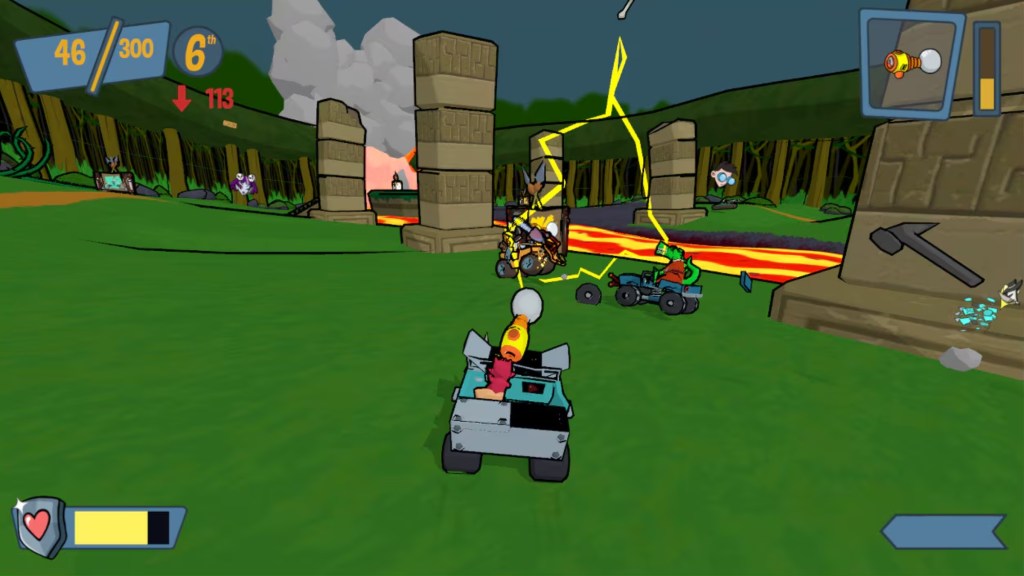Almost a quarter century ago today, the Xbox debuted one of its most distinct launch titles — and I’m still sad that it only remains a cult classic instead of a thriving franchise. The launch of the Microsoft Xbox was a game-changer for the console gaming industry in 2001. Although the console ultimately fell behind the PlayStation 2 and GameCube in terms of raw sales, the introduction of a new competitor just as Sega was stepping away from the console wars brought some fresh blood to the marketplace.
Videos by ComicBook.com
Games like Halo became hits on the console, while other major sellers like Star Wars: Knights of the Old Republic, Dead or Alive 3, Ninja Gaiden, and Fable helped establish it as a more mature-presenting alternative to the more family-oriented GameCube. This even extended to their answer to Mario Kart, a vehicular combat game that still has a passionate (if small) fanbase to this day. While it didn’t sell well at the time and never got the sequel it deserved, I still have a lot of love for Cel Damage.
Cel Damage Should Have Been Xbox’s Mario Kart

I’m still sad that Cel Damage‘s fusion of Looney Tunes aesthetics and Twisted Metal gameplay didn’t connect with a wider audience. Developed by Pseudo Interactive and published through EA, Cel Damage was a vehicle-based shooter that unleashed a host of players onto a large map and pitted them against one another. With a mix of combat, racing, and capture the flag, Cel Damage took a winning formula and tweaked it with a memorably colorful design aesthetic that helped it stand out.
Released just as reality TV was becoming popular, Cel Damage focused on an in-universe demolition derby competition for fame and glory. Because of the cartoonish characters, the excessive violence was tweaked to be more openly slapstick. The classic animation-inspired weapons, like spring-loaded boxing gloves and baseball bats with a nail in them, played into the aesthetic.
Similar to The Legend of Zelda: Wind Waker, the developer’s decision to embrace cel shading led to graphics that were instantly cartoony but surprisingly timeless — helping the game look better decades later than many of its contemporaries. The spirit of the game’s presentation feels pulled directly from a Tex Avery cartoon, with an Al Capone-style duck, anime-inspired goth girls, and goofy little devil all vying for victory in the ring.
This replication of screwball cartoons applies to the game’s physics engine, which ignores realistic wear and tear in lieu of more comically absurd damage. As one of the launch titles for the original Xbox, Cel Damage was perfectly positioned to become a foundational franchise for the console, filling in the party game space alongside killer apps like Halo to become the console’s ideal party game. However, that simply wasn’t meant to be.
I’m Still Waiting On A Sequel Of Cel Damage

Cel Damage could have become a major fixture of the Xbox brand, but its early struggles connecting with audiences and critics doomed it to cult status. Critics at the time of launch were universally impressed with the graphics and physics engine, complimenting Pseudo Interactive for their commitment to the cartoonish presentation and connecting it to the gameplay. Unfortunately, that same gameplay didn’t impress them.
The relatively limited number of stages and poorly balanced weapons left a lot to be desired for critics. The standard gameplay loop could quickly become repetitive as a result, with players quickly memorizing the handful of stages and racing to get the best weapons. The controls weren’t tight enough to compete with other, more refined racing games, and the surprisingly tough CPU opponents proved to be tough teachers for the gameplay mechanics. All in all, it left Cel Damage with overwhelmingly mixed reviews that were, in turn, met with lackluster sales.
Cel Damage was quickly ported over to the GameCube (and the PlayStation 2 in Europe), where it similarly struggled to make an imprint on the overall gaming audience. As a result, Pseudo Interactive’s proposal for a sequel was shot down by the first game’s publisher, EA. Sega, Ubisoft, and Midway Games had similar responses, arguing that the lackluster sales and the tricky marketability for a T-rated cartoony party racer made it too risky an investment to develop a sequel.
In the years since, Cel Damage has lived on as a cult classic, with occasional remasters released on other consoles. However, that hasn’t stopped a passionate fanbase from evolving around the title — this writer included. Cel Damage was chaotic and cartoony in the best of ways. Even when it felt like the CPU was ganging up on you or that the weapons were unbalanced, the memorable gameplay and distinct visuals made it the killer app that just didn’t land. While my hopes for a sequel may never come true, at least I know I’m not the only person who played Cel Damage on the first Xbox and immediately fell in love with the goofy game.








